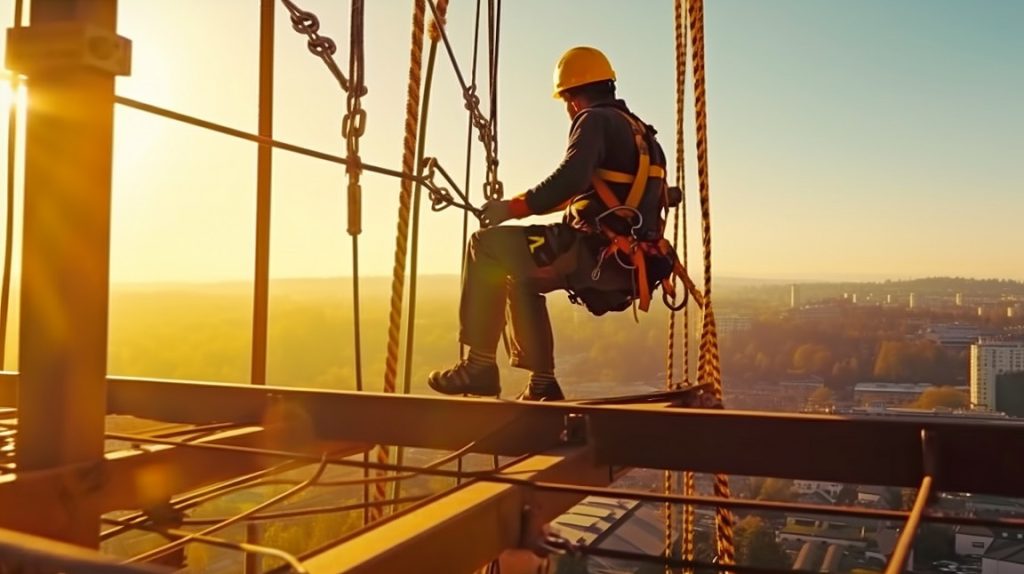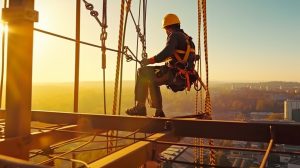Manage Work at Height: Singapore’s Construction Challenge

Generative AI, hanging wires, scaffolding assembly, and construction engineer operating at heights
Singapore’s construction industry faces a peculiar modern dilemma: the need to manage work at height has grown exponentially as the city-state builds upward, yet the human body remains stubbornly unadapted to operate safely in elevated environments where a single misstep triggers consequences that evolution never prepared us to survive. This is not a new problem, of course. Humans have been falling from heights since we first climbed trees in the Rift Valley. What has changed is the scale and frequency of the exposure, and the regulatory apparatus that has evolved, often reactively, to address a hazard that persists despite our best intentions. Understanding why Singapore requires formal training for height work, and why that training so often fails to prevent tragedy, requires examining not merely the physics of falls but the systems that determine who works at height and under what conditions.
The Evolutionary Mismatch
Consider the biological reality: humans possess reasonable depth perception up to about ten metres, adequate for navigating forest canopies where our ancestors foraged. Beyond that distance, our visual systems provide increasingly unreliable information about spatial relationships. At thirty metres, the height of a typical ten-storey building, our brains struggle to accurately assess distance. This perceptual limitation combines with another evolutionary legacy, our relatively slow reaction times when compared to genuinely arboreal species. A gibbon, sensing a branch breaking, can redirect mid-fall with extraordinary speed. A human construction worker on failing scaffolding has perhaps one second to react, often insufficient to prevent catastrophe.
The Workplace Safety and Health Council’s incident reports document this mismatch repeatedly. Workers misjudge distances, underestimate risks, or react too slowly when platforms shift unexpectedly. Training to manage work at height attempts to compensate for these biological limitations through learned behaviour and systematic precautions, essentially building cultural adaptations where evolutionary ones are absent.
The Regulatory Framework and Its Limits
Singapore’s Ministry of Manpower mandates that anyone performing tasks above two metres must complete approved height safety training. This threshold did not emerge from scientific analysis of fall severity but from pragmatic regulatory compromise. Falls from two metres can cause serious injury or death, particularly when victims strike obstacles during descent or land on hard surfaces. The training requirement aims to instill consistent safety practices before workers encounter genuine risk.
The curriculum, standardised across approved training providers, covers essential knowledge:
- Recognition of fall hazards in various construction environments
- Proper selection and use of personal protective equipment including harnesses and lanyards
- Installation and inspection of guardrails, safety nets, and collective protection systems
- Emergency procedures when falls occur despite precautions
- Legal obligations under Singapore’s workplace safety legislation
- Communication protocols for reporting hazards and near-misses
On paper, this appears comprehensive. In practice, effectiveness varies dramatically based on instructor quality, training duration, class size, and whether employers reinforce lessons after certification. A two-day course, the minimum permitted, provides limited time for the repetitive practice necessary to convert conscious knowledge into automatic response. Yet many workers receive exactly this minimum, emerging with certificates but insufficient competence.
The Economics of Prevention
Singapore’s construction industry operates within tight cost constraints despite the city’s evident wealth. Labour represents a significant expense, and training represents time not spent building. This creates pressure to minimise instruction duration and cost. The result is a market where training quality correlates strongly with price, and where employers seeking the cheapest option often obtain minimal compliance rather than meaningful protection.
The mathematics of risk assessment further complicates decisions. Falls from height, whilst deadly when they occur, remain statistically uncommon at properly managed sites. An employer might operate for years without incident, creating false confidence that minimal training suffices. This illusion persists until an accident occurs, at which point the true cost of inadequate preparation becomes apparent through injury compensation, legal penalties, project delays, and reputational damage.
Singapore’s enforcement regime attempts to alter this calculus through inspections and penalties. Companies with poor safety records face increased scrutiny and financial consequences. Yet with thousands of active construction sites, regulatory oversight remains imperfect. Gaps exist where profit-maximising decisions override safety considerations, where migrant workers with limited bargaining power accept inadequate training rather than risk job loss.
The Human Element
Behind the statistics and regulations exist individual workers, many far from home, supporting families on wages that Singapore’s residents would consider insufficient. These workers arrive on construction sites each morning, some to ascend bamboo scaffolding or work from suspended platforms where their safety depends upon training quality they had little power to influence. Their employers selected the training provider, determined the instruction duration, and decided whether to reinforce lessons through ongoing supervision.
Some workers, recognising inadequate preparation, develop personal safety systems through observation and cautious practice. Others, trusting their certificates as evidence of competence, work confidently until circumstances reveal their insufficient skills. The difference between these outcomes often depends on factors having nothing to do with worker capability: the quality of their employer’s safety culture, the experience of their supervisors, and simple luck.
The Path Forward
Improving outcomes requires acknowledging that current approaches, whilst better than no training, remain insufficient. Singapore could mandate longer training programmes, require periodic recertification, or implement more rigorous practical assessments. Each improvement, however, increases costs in an industry already operating on compressed margins, creating political resistance and enforcement challenges.
What remains clear is that as Singapore continues its vertical expansion, the imperative to effectively manage work at height will only intensify, and the systems we construct to protect workers will determine how many return home safely and how many do not.





